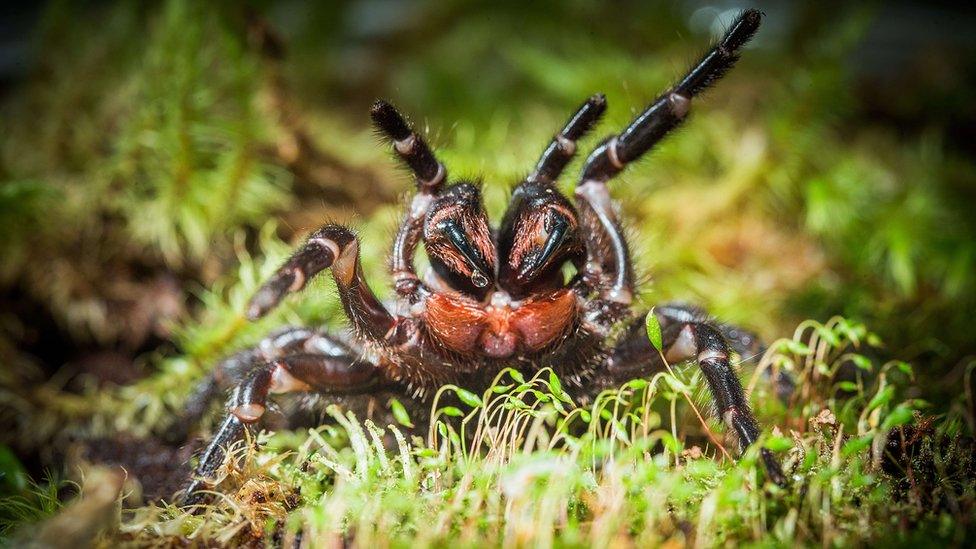Desperately seeking deadly spiders in Australia
- Published
How to catch - and milk - a deadly spider
Every year the Australian Reptile Park puts out an unusual call to members of the public asking for help in catching the funnel-web spider, one of the deadliest species in the country. But how exactly do you go about capturing a dangerous arachnid - and more importantly, why would you?
The funnel-web lives in gardens and trees across the country, and starts to multiply in November. Its prime season is nearly upon Australia.
Since 1981, dutiful citizens have captured thousands of spiders and taken them to the Reptile Park, which uses them to produce an antidote. Male spiders are favoured as they produce much more toxic venom than females.
The programme saves scores of lives each year - last year about 65 people were bitten by the funnel-web spider, which is mostly found in eastern Australia, particularly Sydney.
Over the weekend, the annual plea went out to the public to catch the critters, but this year it was made with a bit more urgency.

There are around 40 species of the funnel-web spider, and scientists found a new species in September
The park needs at least 200 male funnel-web spiders every year to produce enough venom for the antidote - but last year it only collected 100.
Park authorities are not sure why the numbers dropped, but believe it is a combination of fewer spiders being available and fewer members of public catching the arachnids.
"We do not have a shortage of the antidote yet. But if we continue to get these numbers every year, then we will have a problem and potentially a shortage," spider-keeper Stacey Denovan told the BBC.

Spider facts
Named after their irregularly-shaped webs, funnel-web spiders live in moist habitats - such as under logs or shrubbery - or rotting parts of trees.
They sometimes fall into swimming pools, where they can live up to 30 hours under water.
The spiders are between 1-5cm in length, and have shiny carapaces.
Their venom can lead to heart collapse, affect the nervous system and intestines, and cause difficulty in breathing.
There have been 13 recorded deaths from funnel-web spider bites in Australia - nobody has died since the anti-venom programme began.

The clock is ticking.
The antidote has a shelf life of only 18 months, and can take up to two years to produce.
After months of milking spiders, the park sends the venom to a laboratory which takes another nine months to create the antidote - they incubate it in rabbits, which have a higher tolerance than humans and, the park says, suffer no ill effects.

How anti-venom is created

Spiders are milked using a pipette which sucks up their venom. This is done once every week as the spiders can get exhausted from too many milkings.
The park needs between 200 and 300 spiders to milk every year, and needs 3,000 milkings to produce enough venom for the antidote.
The venom is sent to laboratory Bio CSL where it is injected in incremental doses into rabbits.
The bunnies gradually build up antibodies in their blood, which the laboratory extracts to make a serum.

A funnel-web male spider typically lives for only six months, and catching them is more efficient than breeding them - they take up to five years to mature and only then can breeders figure out their sex.
Even so, catching this spider is a dangerous job - so why ask the public to do it?

Funnel-web spiders live in moist habitats - such as under logs or shrubbery - or in rotting parts of trees
Ms Denovan says the privately-owned park, which does not receive government funding even for the anti-venom programme, does not have enough resources and manpower.
As the critters mostly live in an area stretching hundreds of kilometres across NSW, employees could take hours to get to a spider once one is spotted.
"We tell the public that their efforts in catching spiders go towards saving lives," she says.
"As long as they are cautious, it shouldn't be dangerous. The spider can't jump or climb, nor move that fast."

How to catch a funnel-web spider
You should be wearing gardening gloves, trousers, and covered shoes to minimise the chances of a bite.
Get a glass jar with a wide mouth, remove the lid, and pierce it for air holes.
Invert the jar over the spider, then slide a piece of heavy cardboard or solid plastic under the opening to cover it.
Right the jar, keeping the top covered.
Make sure the spider is at the bottom before dropping a moist cotton bud into the jar (the spiders dry out easily and need moisture), then put on the lid.
Keep it away from direct sun and heat.
An alternative is putting an open jar on its side next to the spider, and using a long item such as a ruler to sweep the arachnid into the jar.
Sources: NSW Government - Office of Environment and Heritage, external, Australian Reptile Park